Seneciphylline N-oxide
- CAS NO.:38710-26-8
- Empirical Formula: C18H23NO6
- Molecular Weight: 349.38
- MDL number: MFCD20260632
- SAFETY DATA SHEET (SDS)
- Update Date: 2023-05-04 17:34:38
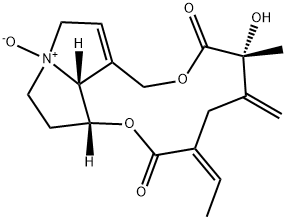
What is Seneciphylline N-oxide?
The Uses of Seneciphylline N-oxide
Seneciphylline N-oxide is a pyrrolizidine alkaloid that is naturally found in the extracts of Adenostyles alliariae, a plant that is native to the western Alps. Seneciphylline N-oxide is highly toxic to mammals and is also a suspected mutagen.
Definition
ChEBI: Spartioidine N-oxide is a pyrrolizine alkaloid that is 13,19-didehydrosenecionane carrying a hydroxy substituent at position 12, two oxo substituents at positions 11 and 16 and an N-oxido substituent. It has a role as a Jacobaea metabolite. It is a macrocyclic lactone, an olefinic compound, an organic heterotricyclic compound, a pyrrolizine alkaloid, a tertiary alcohol and a tertiary amine oxide. It is functionally related to a spartioidine.
General Description
Seneciphylline-N-oxide is a pyrrolizidine alkaloid isolated from Senecio vulgaris. Pyrrolizidine alkaloids are secondary metabolites, produced by several plant species as protection against insect herbivores. Approximately 6000 plant species worldwide may contain pyrrolizidine alkaloids. They are mainly found in the families of the Boraginaceae, Asteraceae and Fabaceae. The PA-content depends on several factors (species, plant organ, harvest, storage, extraction procedures). Contents vary from trace amounts up to 19 % based on dry weight. These alkaloids occur in two forms, as tertiary base PAs and their N-oxide (PANO).
Biological Activity
Seneciphylline N-Oxide is a dehydrogenation product of Senecionine N-oxide. Seneciphylline N-Oxide is a natural compound isolated from root cultures of Senecio erucifolius (Asteraceae).
Source
They are common food contaminants in herbs, tea, salad, leafy vegetables and honey. Feed can be contaminated so that the plant products find their way in the food chain indirectly also over meat, milk and eggs. Pyrrolizidine alkaloids have adverse health effects and were classified as genotoxic, carcinogen and hepatotoxic.
Properties of Seneciphylline N-oxide
| storage temp. | 2-8°C |
| pka | 12.40±0.20(Predicted) |
Safety information for Seneciphylline N-oxide
| Signal word | Danger |
| Pictogram(s) |
 Skull and Crossbones Acute Toxicity GHS06 |
| Precautionary Statement Codes |
P260:Do not breathe dust/fume/gas/mist/vapours/spray. P262:Do not get in eyes, on skin, or on clothing. P264:Wash hands thoroughly after handling. P264:Wash skin thouroughly after handling. P280:Wear protective gloves/protective clothing/eye protection/face protection. |
Computed Descriptors for Seneciphylline N-oxide
New Products
4-AMINO-TETRAHYDRO-PYRAN-4-CARBOXYLIC ACID HCL 4-(Dimethylamino)tetrahydro-2H-pyran-4-carbonitrile 4-Aminotetrahydropyran-4-carbonitrile Hydrochloride (R)-3-Aminobutanenitrile Hydrochloride 3-((Dimethylamino)methyl)-5-methylhexan-2-one oxalate 1,4-Dioxa-8-azaspiro[4.5]decane 5-Bromo-2-nitropyridine Nimesulide BP Aceclofenac IP/BP/EP Diclofenac Sodium IP/BP/EP/USP Mefenamic Acid IP/BP/EP/USP Ornidazole IP Diclofenac Potassium THOMAIND PAPER PH 2.0 TO 4.5 1 BOX BUFFER CAPSULE PH 9.2 - 10 CAP SODIUM CHLORIDE 0.1N CVS ALLOXAN MONOHYDRATE 98% PLATINUM 0.5% ON 3 MM ALUMINA PELLETS (TYPE 73) LITHIUM AAS SOLUTION 2-Bromo-1-(bromomethyl)-3-chloro-5-nitrobenzene 2-Bromo-3-nitroaniline N-(3-Hydroxypropyl)-N-methylacetamide 3-Bromo-6-chloropyridazine 4-ethyl-3-nitrobenzoic acidRelated products of tetrahydrofuran
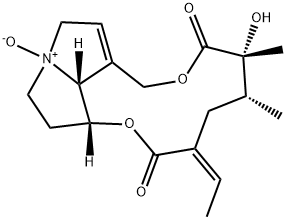
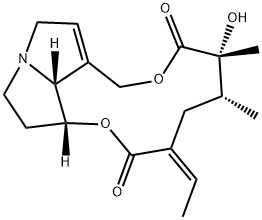
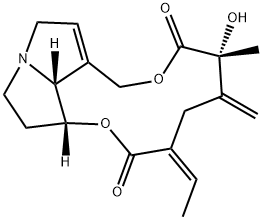
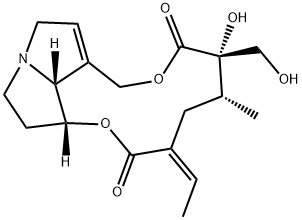
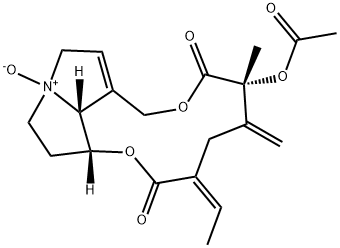
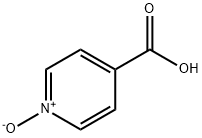

You may like
-
 Seneciphylline N-oxide CAS 38710-26-8View Details
Seneciphylline N-oxide CAS 38710-26-8View Details
38710-26-8 -
 1-Methyl-6-oxo-1,6-dihydropyridazine-3-carbonitrile 98%View Details
1-Methyl-6-oxo-1,6-dihydropyridazine-3-carbonitrile 98%View Details
99903-60-3 -
 1823368-42-8 98%View Details
1823368-42-8 98%View Details
1823368-42-8 -
 2-(3-(tert-butyl)phenoxy)-2-methylpropanoic acid 1307449-08-6 98%View Details
2-(3-(tert-butyl)phenoxy)-2-methylpropanoic acid 1307449-08-6 98%View Details
1307449-08-6 -
 Ethyl 3-(furan-2-yl)-3-hydroxypropanoate 25408-95-1 98%View Details
Ethyl 3-(furan-2-yl)-3-hydroxypropanoate 25408-95-1 98%View Details
25408-95-1 -
 2-Chloro-5-fluoro-1-methoxy-3-methylbenzene 98%View Details
2-Chloro-5-fluoro-1-methoxy-3-methylbenzene 98%View Details
1805639-70-6 -
 1784294-80-9 98%View Details
1784294-80-9 98%View Details
1784294-80-9 -
 Lithium ClavulanateView Details
Lithium ClavulanateView Details
61177-44-4